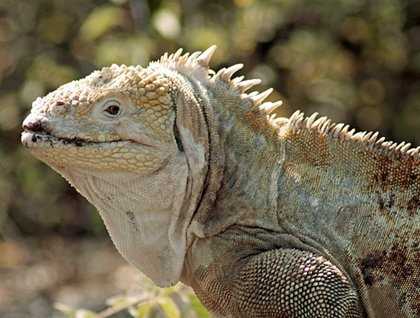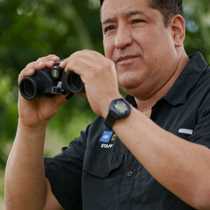A brand new day found us in front of Urbina Bay. This site is of great geological interest for a fantastic event took place here in 1954. The coastal area was violently uplifted prior to volcanic activity on Isabela Island. An earthquake of 6.5 on the Richter scale occurred on June 4th 1954 and the intertidal zone was thrust up, in some cases more than 4 meters (16 feet), out of the ocean trapping invertebrates and leaving various species high and dry. This morning was our opportunity to explore the geological and oceanic past of the uplift and the terrestrial present with species that have little by little arrived to the area since this famous event took place. It is still possible to see the relics of this event- huge pieces of brain coral inland! These massive coral heads have had hundreds of years of buildup of coral polyps that have bleached bright white in the equatorial sun.
During the walk we were surrounded by salt resistant vegetation and Galapagos mocking birds and Darwin finches appearing on the top branches to sing. As we ventured farther inland we came upon a hearty population of Galapagos land iguanas, many of them along the trails. Plentiful native and endemic flowers were found as well, including the beautiful Galapagos cotton and yellow cordia flowers. At the end of the walk we had the chance to cool off on the black lava landing beach with the company of many Galapagos penguins who let us share their space with them.
In the afternoon a short navigation brought us to Tagus Cove which had been a protected cove for sailors for hundreds of years, including the H.M.S. Beagle with Captain Fitzroy and the then young naturalist, Charles Darwin.
After lunch we had an early kayaking outing followed by snorkeling. We put on our gear to explore the underwater world by going deep-water snorkeling in an exotic location that today was at its prime for the waters were not as cool as expected. Visibility was good and we were fortunate to have great sightings. Sea turtles, Galapagos sea lions and even a Flightless cormorant were viewed.
In the late afternoon after the snorkelers came back, we had two more options. Some guests opted to go for a second round of kayaking while others took a Zodiac ride. Both of the excursions were very successful for as we were exploring the outer coast, it brought us close to flightless cormorants and Galapagos penguins. We also saw many blue footed boobies, Brown pelicans, Galapagos sea lions and an occasional Pacific green sea turtle coming up to the surface. The stratification of the Tuff cinder formations was impressive as well, showing the past explosive geological history of the area.
At the end of the day the coast lit up with a warm glow and we return to our ship grateful that life had shown its splendor of this paradise to us today.







